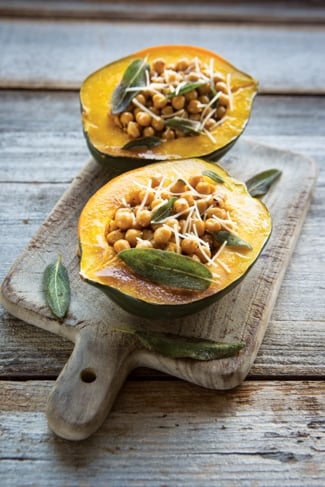
Roasting is a naturally nutritious cooking method that turns everyday ingredients into golden brown dinners.
One of the easiest cooking methods in the kitchen also happens to be the tastiest and healthiest. We’re talking about roasting. Whether meat, fish, vegetables, or tofu, a main course with minimal clean-up can be ready in under an hour.
Roasting locks in flavour, moisture, and nutrition. Its dry, quick heat means your nutrients stay in the food, not washed down the drain with methods like boiling. High output with relatively low input, this warming way to do dinner kicks things up a notch in the taste department, without the need for extra ingredients.
Squash tastes sweeter, chicken is juicier, and broccoli becomes a brand new vegetable. Roasting works its magic other ways, too, transforming bitter and sour lemons into an entirely edible treat (yes, the whole thing!) and garlic cloves into savoury candy. Arm yourself with a cast iron skillet, sheet pan, or glass dish, and reintroduce this high-temperature cooking technique into your New Year’s kitchen.
Recipes
Roasted Brown Butter and Bean Stuffed Acorn Squash with Crispy Sage

Roasted Garlic, Lemon, Chicken, and Kale Skillet Caesar

Roasted Smoky Tomatoes with Swiss Chard and Eggs

Roasted Eggplant and Broccoli Noodles with Five-Spice Ground Tofu

Roasted Maple-Mustard Pork over Brussels Sprout Pilaf

Roasting versus baking
Roasting
- generally over 400 F (200 C)
- dry heat
- uncovered
- food is solid when it goes in (e.g., a whole chicken)—you’re always roasting no matter the temperature when food is solid
- food is often coated in fat to crisp exterior (e.g., squash brushed with oil)
Baking
- up to 375 F (190 C)
- dry heat
- covered or uncovered
- food is liquid when it goes in (e.g., cake batter)
- food has fat in it, not brushed onto it (e.g., butter in cookies)
Gas/conventional versus convection ovens
- As not everyone has a convection feature on their oven, recipes are generally written with conventional (non-convection) ovens in mind.
- Convection ovens have a fan at the back to push air around, cooking food more quickly and at a lower temperature.
- If using a convection oven in a recipe, lower the heat by 25 F (4 C) degrees, and begin checking for doneness earlier, as it cooks faster.
- Delicate baked goods such as cakes, muffins, and baked custards need a gentle heat; keep the convection feature off when making these.
- Convection ovens are ideal for roasting vegetables and meats, lending a crispy exterior to the foods while keeping the interior moist (but this same feature can make food dry, so check for doneness early).
The fuss about trussing
Why truss?
Keeps the food intact, so it cooks evenly, retains its shape, and no extremities become dry during roasting.
What to truss
Whole poultry, stuffed meats such as pork loin roasts, and whole stuffed fish.
How to truss
Whole poultry (the easy way) Using ovenproof twine, secure the legs of the bird by tying them with a bow. Tuck wings under so they don’t flap out and get dry. Snip twine using kitchen scissors to untie before serving.
Stuffed meat and whole stuffed fish Tie loose but secure vertical pieces of ovenproof twine 2 to 4 in (5 to 10 cm) apart. Make as many ties as you need to hold your meat or fish together. Snip twine using kitchen scissors to untie before serving.









